Search results for: Ansoff Matrix
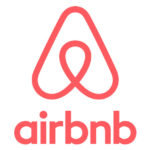
Airbnb is a global hospitality service brokerage company that has more than 6 million listings in more than 191 countries and regions worldwide.[1] Started in 2008, the company became profitable in 2017, with a profit of USD93 million on revenue of USD2.6 billion.[2] Apart from the business beings started at the right place on the right time, Airbnb organizational culture plays an instrumental role in the success of the global accommodation and experience marketplace. Airbnb organizational culture integrates the following three key elements: 1. Inclusivity and acceptance. Airbnb has a welcoming culture for employees, hosts and guests regardless of gender, race, sexual orientation and political views. Inclusivity and acceptance is placed at the core of Airbnb corporate culture. Airfinity employee resource groups within the company facilitate employee relationships through common cultures and backgrounds, as well as interests. There are twelve Airfinity employee resource groups such as LGBTQ, African-American, Latinx, Women in Tech, Veterans, and Parents. 2. Paramount role of company’s vision and mission. While almost all big companies like Airbnb have their vision and mission statements, very few companies apply them on daily business with the same intensity as Airbnb does. Airbnb has chosen a mission “to create a world where anyone can belong anywhere, providing healthy travel that is local, authentic, diverse, inclusive and sustainable”.[3] Regardless of their professional competencies, the global rental and experiences platform only employs candidates whose personal values and worldview resonate well with Airbnb vision and mission. Specifically, “every candidate that makes it through to an interview goes through a set of interviews related to their role, and they have two additional interviews related to core values.”[4] Moreover, the global rental and experiences platform illustrates its unquestioned commitment to its ‘belong anywhere’ vision at all levels. For example, Airbnb offices are ‘belong anywhere…
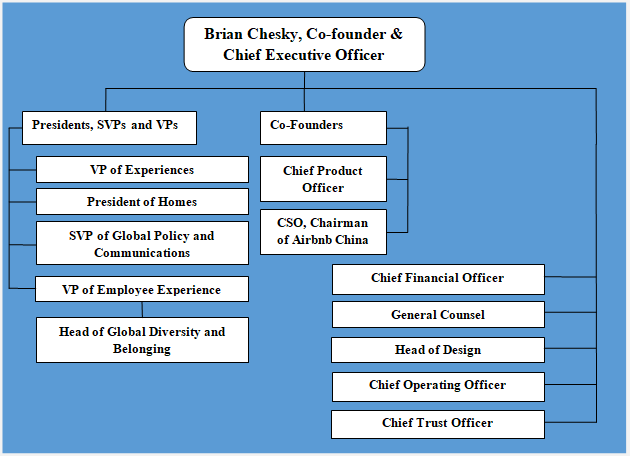
Since its founding in 2008, Airbnb organizational structure has been subjected to changes a number of times to adapt to the growth of the business in at a rapid pace. Furthermore, diversification of the business beyond home rentals to include experiences, adventures and restaurant services necessitated massive changes in its organizational structure. One of the main features of an effective organizational structure is to ensure a rapid flow of information across the company. In order to achieve this, Airbnb CEO Brian Chesky turned to executives from Apple, Facebook, Google and Amazon for advice on how to better organize the company.[1] The latest corporate restructuring at the peer-to-peer lodging company gave more decision making powers to its new business development teams. Holacracy is another important feature of Airbnb organizational structure. Holacracy can be explained as a type of organizational structure where “power is distributed throughout the organization, giving individuals and teams more freedom to self-manage, while staying aligned to the organization’s purpose.”[2] Airbnb organizational structure can be also branded as inter-supportive matrix structure. Airbnb corporate structure integrates many small teams of up to 10 people. The global rental and experiences company promotes the principle of village ecosystem in relationships between its teams. Specifically, if team members need a capability or resource, they can ask other team that has it ask them to share or cooperate. In other words, rather than operating as a separate identities, individual groups within the global lodging company cooperate and support each-other to a great extent and this feature can be specified as one of the main advantages of Airbnb corporate structure. Airbnb Organizational Structure Airbnb Inc. Report contains a full analysis of Airbnb organizational structure. The report illustrates the application of the major analytical strategic frameworks in business studies such as SWOT, PESTEL, Porter’s Five…
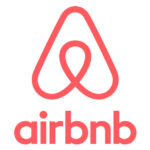
Airbnb leadership practices are contradictory to leadership principles taught in famous business schools worldwide. Nevertheless, the global success of the peer-to-peer lodging company is an undisputed indication of high level of efficiency of Airbnb leadership by CEO Brian Chesky. Airbnb leadership style is integrates the following elements: 1. Going to the source. Airbnb founders Brian Chesky, Joe Gebbia and Nathan Blecharczyk had little or no traditional management experience when they founded the global hospitality service brokerage company. Particularly, Brian Chesky had no business or entrepreneurial experience whatsoever. He dealt with the challenge using the method he calls ‘going to the source’ that is getting advice from top experts in the field. Sources for Airbnb CEO included the likes of Mark Zuckerberg, Reid Hoffman, Marc Andreessen, Jeff Weiner and Jony Ive. Going to the source remains a popular practice at Airbnb to these days and is likely to remain so for the foreseeable future. 2. Managing by visibility. Hands-on approach can be specified as one of the main aspects of Brian Chesky management style. For example, CEO is known to send emails to all employees each Sunday with “whatever is on his mind, which leads to staff replying to him and opening dialogues about various elements of the business”[1] Immersing himself into important details of various business processes allows Chesky to address root causes of the problem and to find innovative solutions to them. 3. Not leading in consensus during the crisis. In 2011 a female host’s apartment was destroyed, the renter took her valuables, and stole her identity while she was travelling for business.[2] While the Chesky gave a response to the incident, the host rebutted in a blog post his claims that the company had done everything it could to help her[3]. Opinions differed within Airbnb senior…
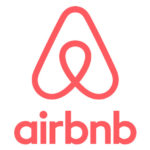
Airbnb, the lodging colossus, has been prudent from the financial point of view. It is important to note that the company hasn’t raised any money from investors since March 2017, when it raised USD448 million. CEO Brian Chesky has pledged to hold an IPO for the 10-year-old company before 2020 when some employee stock grants expire.[1] At a close look, Airbnb business strategy consists of the following three elements: 1. Following a platform business model. A platform business model can be defined as a “business model that focuses on helping to facilitate interactions across a large number of participants”[2] In case of Airbnb, participants are host who offer their properties or organize experiences for guests and travellers who use their services. Airbnb does not own any real estates it lists, not does it host events and experiences it offers. It serves as a broker between suppliers and consumers, receiving a commission of 9% to 15%. 2. High level of technology integration into various business processes. It is a cornerstone of Airbnb business strategy. The company uniquely leverages technology to economically empower millions of people around the world to unlock and monetize their spaces, passions and talents to become hospitality entrepreneurs.[3] The travel industry disruptor currently uses machine learning to improve search, prevent fraud, help hosts optimize pricing, match users with the most relevant listings and other practices vital for the business. Moreover, Airbnb is exploring machine learning algorithms and AI to build a deeper understanding of images, improve reviews using natural language processing (NLP) and support more advanced search using NLP. 3. Focus on community and trust. Cultivating community and maintaining trust among stakeholders is one of the solid bases of Airbnb competitive advantage. The global lodging company maintains a community centre as a place to connect…
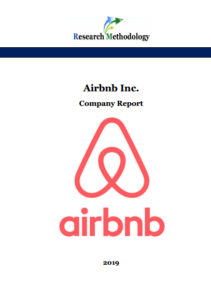
Airbnb Inc. is a global hospitality service brokerage company. It is an online marketplace for peer-to-peer lodging, as well as, tourism and experiences services. Founded in 2008 in San Francisco, USA, Airbnb has become a lodging colossus and travel industry disruptor with more than 6 million listings in more than 191 countries and regions worldwide. There are about 100000 cities with Airbnb listings and 500 million Airbnb guest arrivals all-time. Moreover, more than 2 million people on average stay on Airbnb each night and there are more than 30000 Airbnb experiences worldwide. The company employs about 5000 employees worldwide. Airbnb’s business has doubled almost every year of its existence. It became profitable in 2017, with a profit of USD93 million on revenue of USD2.6 billion. This is a stark contrast from heavily loss-making sharing companies such as Uber and Lyft. It is estimated that in 2018 Airbnb surpassed the performance of the previous year and by 2020, its revenue is projected to be as much as USD8.5 billion. The peer-to-peer lodging company is valued at about USD 31 billion. The company’s mission is to create a world where anyone can belong anywhere, providing healthy travel that is local, authentic, diverse, inclusive and sustainable. Airbnb business strategy effectively contributes to this mission. Airbnb business strategy is associated with platform business model and accordingly, instead of owning the services it offers, the company engages as a broker between suppliers and consumers, receiving a commission of 9% to 15%. Moreover, increasing level of technological integration into various aspects of the business can be specified as one of the critical features of Airbnb business strategy. The global hospitality service brokerage company also places its community and trust among organizational stakeholders at the forefront of its business strategy. The travel industry disruptor has certain weaknesses…
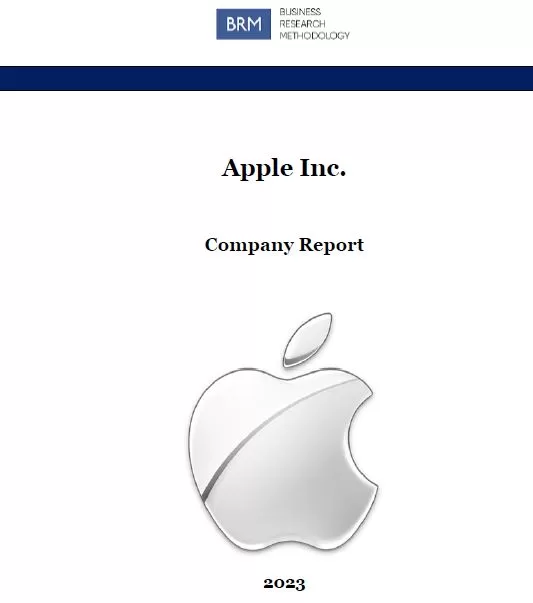
Established in 1977 in California, Apple Inc. is a global designer, manufacturer and marketer of mobile communication and media devices, personal computers, and portable digital music players. Apple is the largest IT company in the world by revenue and total assets and the second-largest mobile phone manufacturer. The company also sells a variety of related software, services, accessories, networking solutions, and third-party digital content and applications. Apple’s ability to design and develop its own operating systems, hardware, application software and services to provide its customers products and solutions with innovative design is placed at the core of its business strategy. As of September 2022, Apple had approximately 164,000 full-time equivalent employees . The net sales of the world’s largest IT company by revenue increased 8% or USD 28,5 billion during 2022 compared to 2021. Higher net sales in Services and Wearables, Home and Accessories categories played an instrumental role in achieving such a growth. Apple business strategy comprises focusing on design and capabilities of products and ever-strengthening the company’s ecosystem. The first company ever to be valued at USD1 trillion purposefully cultivates a reputation for not paying dividends to investors. In short-to-medium term perspective, Apple is working towards decreasing dependence of the business on the sales of iPhones. Leadership style at Apple is known to be democratic. CEO Tim Cook practices ‘quiet leadership’ and he is widely recognized as an effective leader. At the same time, a number of industry watchers and analysts criticize Tim Cook for the lack of innovative genius his predecessor legendary Steve Jobs used to possess. Apple has hierarchical organizational structure. Moreover, the company’s organizational structure also integrates product-based grouping with a focus on collaboration between different groups and divisions. Organizational culture of the multinational technology company, on the other hand, fosters creativity and innovativeness coupled…
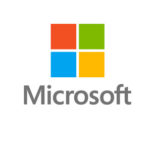
Microsoft corporate social responsibility (CSR) is guided by the citizenship mission of the company which is “to serve globally the needs of communities and fulfil our responsibilities to the public”. Moreover, charitable activities of Bill & Melinda Gates Foundation founded by Microsoft founder Bill Gates is also associated with Microsoft in the perception of the general public to a certain extent. The technology giant won a number of awards and achievements for its responsible behaviour. These include ranking #1 on Corporate Responsibility Magazine’s 100 Best Corporate Citizens 2018, ranking #1 for both, Environment and Social Score which measures corporate performance using more than 200 factors. Moreover, Microsoft’s behavior as a socially responsible company has earned number 2 spot on JUST Capital’s Top 10 Tech Companies. Microsoft CSR Programs and Initiatives Microsoft Supporting Local Communities Microsoft employees donated USD158 million to non-profits serving its local communities and the world The Lagos Solar project in Nigeria uses batteries that are charged by solar panels, along with intelligent inverters connected to Microsoft Azure Internet of Things technology International software provider Temenos relies on Microsoft Cloud services to reach people across Myanmar who lack access to banking, giving them opportunities for more financial stability and access to microcredit and other financial services. Microsoft’s 4Afrika Initiative provides a set of programs to empower African youth, entrepreneurs, developers and business and civic leaders YouthSpark initiative aims to empower 300 million young people around the world with opportunities for education, employment, and entrepreneurship Microsoft Educating and Empowering Workers Microsoft collects employee feedbacks through multiple channels and acts on them. As part of this initiative nearly 85 percent of our more than 117,000 employees responded employee survey 92% of surveyed stated they feel proud to work at Microsoft and 87% of employees would recommend Microsoft as a great…
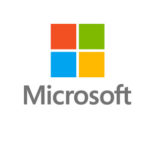
Microsoft ecosystem integrates the following types of products and services: Category Products and services Productivity and Business Processes Microsoft 365, SharePoint, Skype for Business, Outlook Mobile, One Drive, Dynamics 365, Microsoft Teams, Linked In Intelligent Cloud Server products and cloud services, including SQL Server, Windows Server, Visual Studio, System Center, and related CALs, as well as Azure Enterprise Services, including Premier Support Services and Microsoft Consulting Services More Personal Computing Windows Devices, including Microsoft Surface (“Surface”), phones, and PC accessories. Gaming, including Xbox hardware; Xbox Live, Search advertising. Products and services within Microsoft Ecosystem It can be argued that Microsoft ecosystem is aimed at enterprise customers to a greater extent compared to individual users. Specifically, Microsoft enterprise products and cloud services are effectively tied together and this generates strong incentives for businesses to use Microsoft products and services. For example, OneDrive for Business leads into Sharepoint, Teams integrates with Outlook and is about to swallow Skype for Business, Dynamics CRM and SQL Server can integrate and pull data from Azure AD. Moreover, there are many Office 365 programs and services that integrate with each other under a single sign-on. Similarly, Windows ecosystem which includes the platform, games, apps, the Store, and Minecraft, as well as the Windows 10 family of devices, including Surface, Xbox, and HoloLens. the multinational technology company is expected to further invest into its ecosystem to make it stronger in the medium-term and long-term perspectives. Microsoft Corporation Report contains a full analysis of Microsoft ecosystem. The report illustrates the application of the major analytical strategic frameworks in business studies such as SWOT, PESTEL, Porter’s Five Forces, Value Chain analysis, Ansoff Matrix and McKinsey 7S Model on Microsoft. Moreover, the report contains analyses of Microsoft leadership, business strategy, organizational structure and organizational culture. The report also comprises…
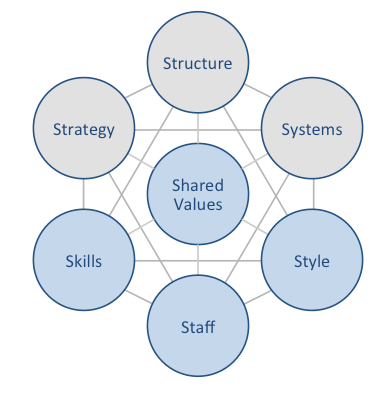
Microsoft McKinsey 7S model shows how seven elements of businesses can be aligned to increase effectiveness. According to this framework, strategy, structure and systems represent hard elements, whereas shared values, skills, style and staff are soft elements. McKinsey 7S model stresses the presence of strong links between elements in a way that a change in one element causes changes in others. As it is illustrated in figure below, shared values are positioned at the core of Microsoft McKinsey 7S model, since shared values guide employee behaviour with implications in their performance. Microsoft McKinsey 7S model Hard Elements in Microsoft McKinsey 7S Model Strategy. Microsoft business strategy can be classified as product differentiation. The company develops advanced technology products and services and sells them for premium costs. Moreover, Microsoft business strategy is currently focused on “cloud-first, mobile-first”, growth through mergers and acquisitions and exploring business opportunities related to augmented and virtual reality. As the latest addition to its business strategy, the multinational technology company is focusing on the concept of ‘tech intensity’, which aims to position Azure as the worlds’ computer with evident positive implications on the long-term growth prospects of the business. Structure. Microsoft organizational structure is divisional and such a structure resulted from a restructuring initiative introduced by CEO Satya Nadella in 2015. Microsoft engineering group is divided into three divisions: Cloud and AI Group, Experiences + Devices and Artificial Intelligence and Research. Business functions, on the other hand, are divided into nine divisions. Microsoft corporate structure is highly dynamic and ever-evolving to meet the demands of changing external market place. Systems. There is a wide range of systems that are critically important to run Microsoft successfully. These include employee recruitment and selection system, team development and orientation system, transaction processing systems, customer relationship management system, business…
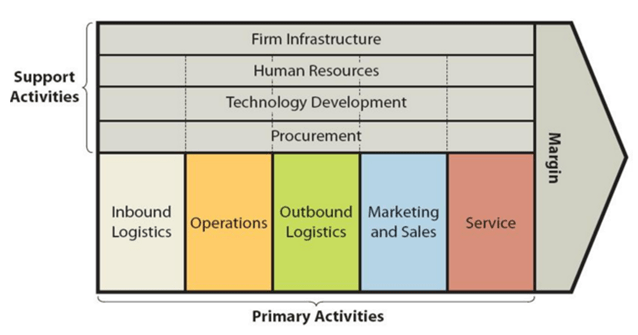
Microsoft value chain analysis is an analytical framework that assists in identifying business activities that can create value and competitive advantage to the business. Figure 1 below illustrates the essence of Microsoft value chain analysis. Figure 1 Microsoft Value Chain Analysis Microsoft Primary Activities Microsoft Inbound logistics Microsoft contracts with multiple suppliers internationally, as illustrated in Figure 2 below. Accordingly, the company has to maintain highly complicated supply-chain operations without any disruptions. It is compulsory of all suppliers to adhere to Microsoft Supplier Code of Conduct and The Microsoft Supplier Requirements. The main sources of value for Microsoft inbound logistics include the economies of scale, presence of strategic relationships with suppliers and in-depth knowledge of supply-chain management practices due to selling relevant software i.e. Microsoft Dynamics AX. Figure 2 Microsoft production supplier locations[1] Microsoft Operations Microsoft Corporation business is divided into the following three operating segments: 1. Productivity and Business Processes. This segment comprises Microsoft products and services related to productivity, communication, and information services. The segment comprises a range of devices and platforms such as Office Commercial, Office Consumer LinkedIn and Dynamics. 2. Intelligent Cloud. This operating segment includes public, private, and hybrid server products and cloud services that can power modern business. Intelligent Cloud segment comprises server products such as SQL Server, Windows Server, Visual Studio, System Center, and related CALs, and Azure, as well as, Enterprise Services, such as Support Services and Microsoft Consulting Services. 3. More Personal Computing. This segment consists of products and services geared towards harmonizing the interests of end users, developers, and IT professionals across screens of all sizes. Microsoft’s regional centre in Ireland supports the European, Middle Eastern, and African region; the centre in Singapore supports the Japan, India, Greater China, and Asia-Pacific region; and the centres in Fargo, North…
